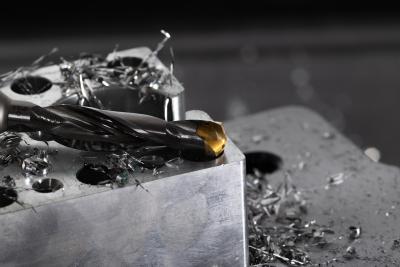
Kennametal adds to its KenTIP™ FS modular drill platform by leveraging the patent-protected GOdrill™ technology for a new insert, the KenTIP FS GTP, along with several new straight-fluted drills for multiple materials and applications including the KenTIP FS SCF and KenTIP FS BF Holders.
KenTIP FS GTP: Using the 140-degree solid carbide point design from Kennametal’s GOdrill™, the KenTIP FS GTP insert allows for multiple machining applications across a range of materials including steel, stainless steel and cast iron. KenTIP FS GTP also features excellent centering capabilities, even at moderate cutting parameters, and low-axial forces.
KenTIP FS SCF Holders: The KenTIP FS SCF Holders feature a straight-fluted design for static applications on lathes. The SCF shank with flange allows for quick and easy usage on common lathe turrets. With this new addition to the KenTip FS portfolio, machinists can expect reliable chip evacuation and maximum torsion resistance, plus superb temperature control and lubrication because of an internal coolant supply with four exits.
KenTIP FS BF Holders: These straight-fluted drills for drilling, countersinking and chamfering (in one operation) a feature Weldon shank for standard BF adaptors. The straight flute design enables the length to be adjusted and delivers reliable chip evacuation and maximum torsion resistance. With internal coolant supply at four exits, the KenTIP FS BF Holders deliver superb temperature control.
Contact Details
Related Glossary Terms
- centering
centering
1. Process of locating the center of a workpiece to be mounted on centers. 2. Process of mounting the workpiece concentric to the machine spindle. See centers.
- chamfering
chamfering
Machining a bevel on a workpiece or tool; improves a tool’s entrance into the cut.
- coolant
coolant
Fluid that reduces temperature buildup at the tool/workpiece interface during machining. Normally takes the form of a liquid such as soluble or chemical mixtures (semisynthetic, synthetic) but can be pressurized air or other gas. Because of water’s ability to absorb great quantities of heat, it is widely used as a coolant and vehicle for various cutting compounds, with the water-to-compound ratio varying with the machining task. See cutting fluid; semisynthetic cutting fluid; soluble-oil cutting fluid; synthetic cutting fluid.
- countersinking
countersinking
Cutting a beveled edge at the entrance of a hole so a screw head sits flush with the workpiece surface.
- lathe
lathe
Turning machine capable of sawing, milling, grinding, gear-cutting, drilling, reaming, boring, threading, facing, chamfering, grooving, knurling, spinning, parting, necking, taper-cutting, and cam- and eccentric-cutting, as well as step- and straight-turning. Comes in a variety of forms, ranging from manual to semiautomatic to fully automatic, with major types being engine lathes, turning and contouring lathes, turret lathes and numerical-control lathes. The engine lathe consists of a headstock and spindle, tailstock, bed, carriage (complete with apron) and cross slides. Features include gear- (speed) and feed-selector levers, toolpost, compound rest, lead screw and reversing lead screw, threading dial and rapid-traverse lever. Special lathe types include through-the-spindle, camshaft and crankshaft, brake drum and rotor, spinning and gun-barrel machines. Toolroom and bench lathes are used for precision work; the former for tool-and-die work and similar tasks, the latter for small workpieces (instruments, watches), normally without a power feed. Models are typically designated according to their “swing,” or the largest-diameter workpiece that can be rotated; bed length, or the distance between centers; and horsepower generated. See turning machine.
- shank
shank
Main body of a tool; the portion of a drill or similar end-held tool that fits into a collet, chuck or similar mounting device.

